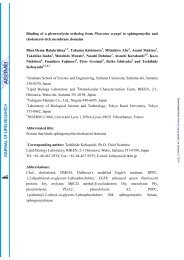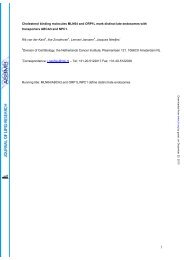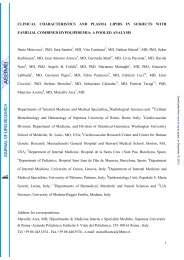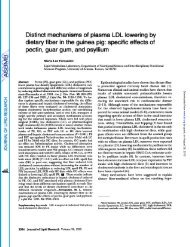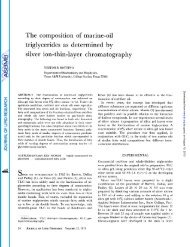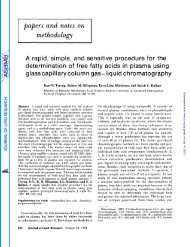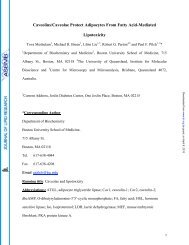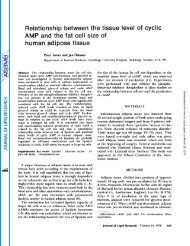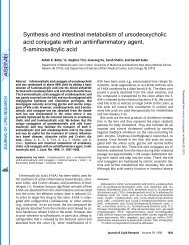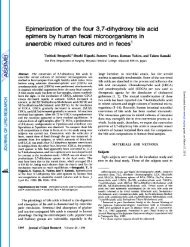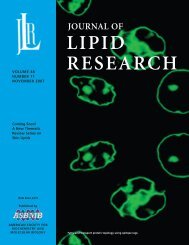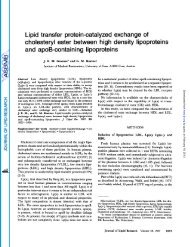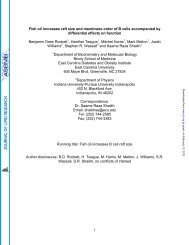Cholesterol gallstone dissolution in bile - The Journal of Lipid ...
Cholesterol gallstone dissolution in bile - The Journal of Lipid ...
Cholesterol gallstone dissolution in bile - The Journal of Lipid ...
You also want an ePaper? Increase the reach of your titles
YUMPU automatically turns print PDFs into web optimized ePapers that Google loves.
TABLE 1. Static disk experiments: cholesterol solubilities, <strong>dissolution</strong> rates and <strong>dissolution</strong> rate constants"<br />
(:holesterol monohydl-ate (ChM)<br />
Equilibrium soluhility" (mM)<br />
(mgitll)<br />
Mole5 <strong>of</strong> <strong>bile</strong> saltimole <strong>of</strong><br />
rholesterol"<br />
Dissolution rate<br />
(mlnoIes.cm".sec~') X 10'<br />
Dissolution rate constant"<br />
(c.lll.sec--') x 104<br />
:\nhvdrous cholesterol (Chi\)<br />
Equilibrium solubility'' (mM)<br />
(mgidl)<br />
Moles o f. <strong>bile</strong> s;dtimole o f<br />
cholesterol"<br />
Dissolution rate<br />
(rrlmoles.cnl-2.sec~1) X 10'<br />
Dissolution rate constant"<br />
(cn1.5cc.") x 10'<br />
(:I)(:" (;(:r)c nxx; UDC GUDC TUDC<br />
6.1<br />
(236)<br />
16: 1<br />
11.2<br />
2.03<br />
8.0<br />
(312)<br />
13: 1<br />
29.2<br />
4.32<br />
2.2<br />
(86)<br />
45: I<br />
2..i<br />
1.25<br />
3.0<br />
(1 16)<br />
33: 1<br />
5.0<br />
1.86<br />
1.5<br />
(57)<br />
68: 1<br />
1.8<br />
1.29<br />
2 .o<br />
(76)<br />
50: I<br />
3.6<br />
2.00<br />
0.33<br />
(1 2.8)<br />
303: 1<br />
0.39<br />
1.27<br />
0.38<br />
(14.7)<br />
265: 1<br />
0.93<br />
2.80<br />
0.19<br />
(7.5)<br />
526: 1<br />
0.09<br />
0.46<br />
0.36<br />
(13.9)<br />
278: 1<br />
1l.d.'<br />
I1.d.<br />
0. I3<br />
(5.0)<br />
770: 1<br />
0.07<br />
0.58<br />
0.28<br />
(10.8)<br />
I' Conditions were: <strong>bile</strong> salt concentrations, 100 mM; 0.15 M Na+: 37°C. pH 10.0 (free and glyc<strong>in</strong>e conjugates)<br />
pH 7.0 (taur<strong>in</strong>e conjugates), 25 ml total volume.<br />
" See list <strong>of</strong> ahhre\iations <strong>in</strong> text.<br />
' (;s <strong>in</strong> No)es-Nernst equation (Eq. la and Ib).<br />
" S;lturation ratio, (mol wt <strong>of</strong> ChA = 387: mol wt <strong>of</strong> ChM = 403).<br />
" "k" <strong>in</strong> Noyes-Nernst equation (Eq. lh).<br />
'n.tl.: not determ<strong>in</strong>ed.<br />
respond<strong>in</strong>g <strong>dissolution</strong> rate constants (k) were found 10.4 kcal/mol for ChA <strong>dissolution</strong>. In view <strong>of</strong> their<br />
to be <strong>in</strong>variant with all <strong>bile</strong> salt concentrations. <strong>The</strong> magnitude, the values strongly suggest that cholesvalues<br />
found were 2.1 X 10P (cm .set") for 25- terol <strong>dissolution</strong> <strong>in</strong> <strong>bile</strong> salt solutions is non-diffusion-<br />
150 nlM concentrations <strong>of</strong> CDC and 1.2 x 10P (cm. controlled s<strong>in</strong>ce E* for a diffusion-controlled process<br />
sec") for the same concentrations <strong>of</strong> UDC.<br />
should be less than 6 kcal/mol (18). <strong>The</strong> curves when<br />
Influence <strong>of</strong> <strong>in</strong>creases <strong>in</strong> temperature on<br />
<strong>dissolution</strong> rates <strong>of</strong> ChM and ChA <strong>in</strong> CDC<br />
solutions-static disk method<br />
extrapolated to higher temperatures <strong>in</strong>tersect at<br />
86.7"C. 'This temperature is identical to the first thermotropic<br />
phase transition temperature (86.4 2 0.5"C)<br />
<strong>of</strong> ChM <strong>in</strong> excess water observed by differential<br />
<strong>The</strong> <strong>dissolution</strong> rates <strong>of</strong> ChM and ChA together with scann<strong>in</strong>g calorimetry (8) and which has been shown<br />
their <strong>dissolution</strong> rate constants (k) and equilibrium by X-ray diffraction to represent the conversion <strong>of</strong><br />
cholesterol solubilities (Cs) <strong>in</strong> 100 mM CDC are sum- ChM to ChA (8).<br />
marized <strong>in</strong> Table 2. It is apparent the <strong>in</strong>creases <strong>in</strong><br />
temperature have only ;I small effect on equilibrium<br />
ChM solubility (Cs). However, s<strong>in</strong>ce the <strong>in</strong>itial dis-<br />
Dissolution <strong>of</strong> ChM and ChA <strong>in</strong> CDC solutionsrotat<strong>in</strong>g<br />
disk method and the Levich equation (Eq. 2)<br />
solution rates <strong>in</strong>crease dramatically between 17 and In order to exam<strong>in</strong>e critically whether ChM and<br />
47"C, the rate constants are <strong>in</strong>creased significantly ChA <strong>dissolution</strong> <strong>in</strong> <strong>bile</strong> salt solutions is "diffusion-<br />
(Table 2). In order to calculate the activation energies controlled" or "non-diffusion-controlled," we carried<br />
<strong>of</strong> <strong>dissolution</strong>, the rate constants are plotted accord<strong>in</strong>g out <strong>dissolution</strong> studies at different r.p.m. (40-800)<br />
to the .Ar-rhenius equation (Fig. 9)<br />
employ<strong>in</strong>g rotat<strong>in</strong>g disks <strong>of</strong> ChM and ChA <strong>in</strong> 50 ml<br />
d(1nk)<br />
E* = RT2dT<br />
Eq. 5<br />
<strong>of</strong> 100 mM CDC (pH 10.0, 37°C) as described <strong>in</strong><br />
Methods. <strong>The</strong> <strong>in</strong>itial <strong>dissolution</strong> rates <strong>of</strong> cholesterol<br />
are plotted <strong>in</strong> Figs. 10A and 10B and show <strong>in</strong>creases<br />
where E* is the activation energy <strong>in</strong> cal/mol, R and T <strong>in</strong> rates as a function <strong>of</strong> r.p.m. with ChA be<strong>in</strong>g uniare<br />
the gas constant and absolute temperature, re- formly faster than ChM. <strong>The</strong>se values together with<br />
spectively, and k is the <strong>dissolution</strong> rate constant. <strong>The</strong> the angular velocities (u), Reynolds numbers, and<br />
graph (Fig. 9) <strong>in</strong>dicates that the functional depend- <strong>dissolution</strong> rate constants are summarized <strong>in</strong> Table 3.<br />
ence <strong>of</strong> k on 1/T is l<strong>in</strong>ear for both ChM and ChA with By plott<strong>in</strong>g the k values (Table 3) for both ChA and<br />
slightly different slopes. <strong>The</strong>se slopes give activation ChM <strong>dissolution</strong> accord<strong>in</strong>g to Eq. 2 (<strong>of</strong> Levich), it<br />
energies <strong>of</strong> 13.7 kcal/mol for ChM <strong>dissolution</strong> and is apparent (Fig. 11A) that the data fall on two l<strong>in</strong>ear<br />
357: 1<br />
Igimi and Carey K<strong>in</strong>etics <strong>of</strong> cholesterol <strong>gallstone</strong> <strong>dissolution</strong> 261<br />
n.d.<br />
l1.d.<br />
Downloaded from<br />
www.jlr.org by guest, on June 9, 2013



